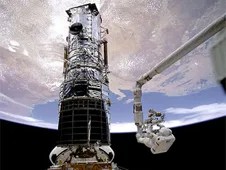3 min read
Since its launch in April 1990, NASA’s Hubble Space Telescope has become a familiar icon to millions of people from Cincinnati to Singapore and continues to excite astronomers around the world with its discoveries.
Astronaut F. Story Musgrave, anchored on the Space Shuttle Endeavor’s robotic arm, prepares to be elevated to the top of the Hubble Space Telescope during Hubble’s first servicing mission in 1993.
Click image for enlargement.
Credit:
NASA
Just a few of Hubble’s accomplishments include measurement of the current rate of expansion of the universe (the Hubble Constant), the “shocking” discovery that the expansion of the universe is speeding up, and the determination of an accurate age of the cosmos of 13.7 billion years. Hubble showed that titanic gamma-ray bursts first observed by Air Force satellites originate in distant galaxies. Hubble made the first accurate measurement of the mass of a super-massive black hole and performed the first “demographic” survey of super massive black holes that exist at the centers of nearly all galaxies. Hubble made the first observations of the chemical makeup of the atmosphere of a planet orbiting another star and provided the first high-resolution maps of the structures of planet-forming disks of dust and debris around ordinary stars like the sun.
Not surprisingly, many of these discoveries would not be possible if engineers had not designed Hubble to be serviced in space. Thanks to four previous service calls to Hubble – Servicing Mission 1 in 1993, Servicing Mission 2 in 1997, Servicing Mission 3A in 1999 and Servicing Mission 3B in 2002 – the telescope’s capabilities have progressed along with advancements in technology.
In 2009, astronauts will visit this old friend one last time. During the five planned Extra Vehicular Activities, or spacewalks, the crew will replace aging gyroscopes, install two new science instruments called the Wide Field Camera 3 and the Cosmic Origins Spectrograph, swap out Hubble’s original batteries, and install a Fine Guidance Sensor.
If all goes as planned, the astronauts will also attempt the first ever on-orbit repair of two science instruments – the Space Telescope Imaging Spectrograph, which stopped functioning in August, 2004, and the Advanced Camera for Surveys, which stopped working in January 2007.
The fifth shuttle mission to Hubble is targeted for launch in 2009. Three of the seven astronauts selected for this mission will be making a return visit to Hubble, and all are rigorously training to prepare for what could be their most challenging mission yet.
Please join us for this amazing ride. Check back each month for a ‘behind-the-scenes’ look at just what it takes to successfully test instruments and other hardware. Gain insight into difficult tasks the astronauts must successfully accomplish here on Earth in order to master those seemingly simple spacewalks.
Related link:
Susan Hendrix
NASA's Goddard Space Flight Center








